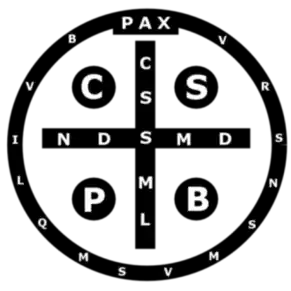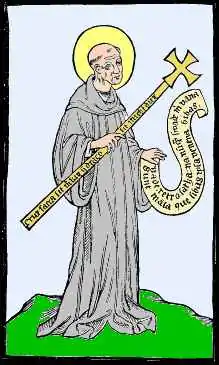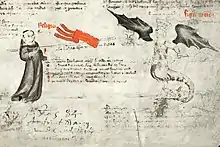Vade retro satana
VADE RETRO SATANA ("Go back, Satan" or "Step back, Satan", "Back off, Satan") is a Medieval Catholic formula for exorcism, recorded in a 1415 manuscript found in the Benedictine Metten Abbey in Bavaria;[1][2] its origin is traditionally associated with the Benedictines. The initials of this formula (VRSNSMV SMQLIVB or VRS:NSMV:SMQL:IVB) have often been engraved around crucifixes or Catholic Saint Benedict Medals at least since 1780.[3][4][5][6]

The phrase vade retro satana (often spelled vade retro satanas, or sathanas) is also used as a witty or scholarly prose device, dissociated from its religious implications, to express strong rejection of an unacceptable (but possibly tempting) proposal, or dread of some looming menace. Namely, in the sense of "do not tempt me!", "I will have nothing to do with that", "will someone deliver us from that", and so on.[7]
Text

The Latin text says:
- CRUX SACRA SIT MIHI LUX / NON DRACO SIT MIHI DUX
- VADE RETRO SATANA / NUNQUAM SUADE MIHI VANA
- SUNT MALA QUAE LIBAS / IPSE VENENA BIBAS
In approximate translation:
- "May the Holy Cross be my light / May the dragon never be my guide
- Begone Satan / Never tempt me with your vanities
- What you offer me is evil / drink the poison yourself."
Origins and history
The verse VADE RETRO SATANA is similar to a phrase spoken by Jesus to Peter in the Vulgate New Testament, Gospel of Mark 8:33: vade retro me satana ("Get behind me Satan!"[Mark 8:33]).[8][9]
The exact origin of the passage is not clear.[10] It is found in an early thirteenth century legend of the Devil's Bridge at Sens, wherein an architect sold his soul to the devil and then subsequently repented. M. le Curé of Sens, wearing his stole, exorcised the devil, driving him away with holy water and these words, which he made the penitent repeat.[11]
The passage came to general attention in 1647, when women who were prosecuted for witchcraft declared that they had been unable to do harm where there was a cross, and the St. Michael's Benedictine Abbey in Metten was particularly exempt from their influence.[1] A search of the monastery turned up crosses painted on the walls with the formula's initials. The meaning of those letters remained a mystery for some time, until the complete verses were found in a manuscript dating to 1415 in the abbey's library,[12] next to an image of St. Benedict.
The same formula was later found in an Austrian manuscript from 1340/50.[13] The manuscript depicts Satan offering a drinking cup to the Saint, who keeps him at bay with a long cross-topped staff carrying a red banner. Below the staff is a single line of text, and below it are six lines of verse, starting with "Vade retro Sathana".

The formula received the approval of Pope Benedict XIV, and became part of the Roman Catholic ritual in 1742. The formula's popularity grew considerably in the 19th century, mainly due to the efforts of Leo Dupont. According to H. C. Lea (1896), "As a rule ... it suffices to wear [the medal] devoutly, but, if some special favor is desired, it is advisable on a Tuesday to say five Glorias, three Aves and then three more Glorias to secure the protection of St. Benedict."[14]
The VADE RETRO SATANA remains part of the Roman Catholic ritual following the 20th-century revision of the ritual and its final promulgation in 1999 via De exorcismis et supplicationibus quibusdam.[15]
See also
References
- Martín de Elizalde, Revista Coloquio, n. 4. Italian translation: La Croce di San Benedetto ("The Cross of St. Benedict")
- "Order of St. Benedict". Osb.org. Retrieved 2013-04-22.
- Journal of the British Archaeological Association, 1858, page 280
- Judith Sutera, 1997, The Work of God: Benedictine Prayer Published by Liturgical Press ISBN 0-8146-2431-6 page 109
- Lea, Henry Charles (1896) page 520
- Ann Ball, 2003 Encyclopedia of Catholic Devotions and Practices ISBN 0-87973-910-X pages 350–351
- See for example: Sir Walter Scott, The Fortunes of Nigel, 1822, Ch. 31: "Ne inducas in tentationem—Vade retro, Sathanas!—Amen."
- "Evangelium Secundum Marcum". Nova Vulgata Bibliorum Sacrorum Editio (in Latin). Holy See. Retrieved 2008-11-04.; "The Gospel According to Mark". New American Bible. Holy See. Retrieved 2009-11-27.
- Dom Prosper Gueranger. "The Medal or Cross of St Benedict". www.liturgialatina.org. Retrieved 2018-08-05.
- Ott, M. (1912). "Medal of Saint Benedict". The Catholic Encyclopedia. New York: Robert Appleton Company. Retrieved June 5, 2009.
- "Odd Phrases in Literature", The Irish Quarterly Review, Volume 6, Part 1, 1856, note p. 683
- Manuscript Clm 8210, Bavarian State Library
- Cod. Guelf. 35a Helmst. (Biblia pauperum, 14. Jh.), Wolfenbüttel Library, image 3
- Lea, Henry Charles (1896) A History of Auricular Confession and Indulgences in the Latin Church; Volume III: Indulgences. Philadelphia: Lea Brothers & Co. Reprinted 2002, Adamant Media Corp. ISBN 1-4021-6108-5
- De exorcismis et supplicationibus quibusdam Libreria Editrice Vaticana, 2003 ISBN 88-209-4822-2
